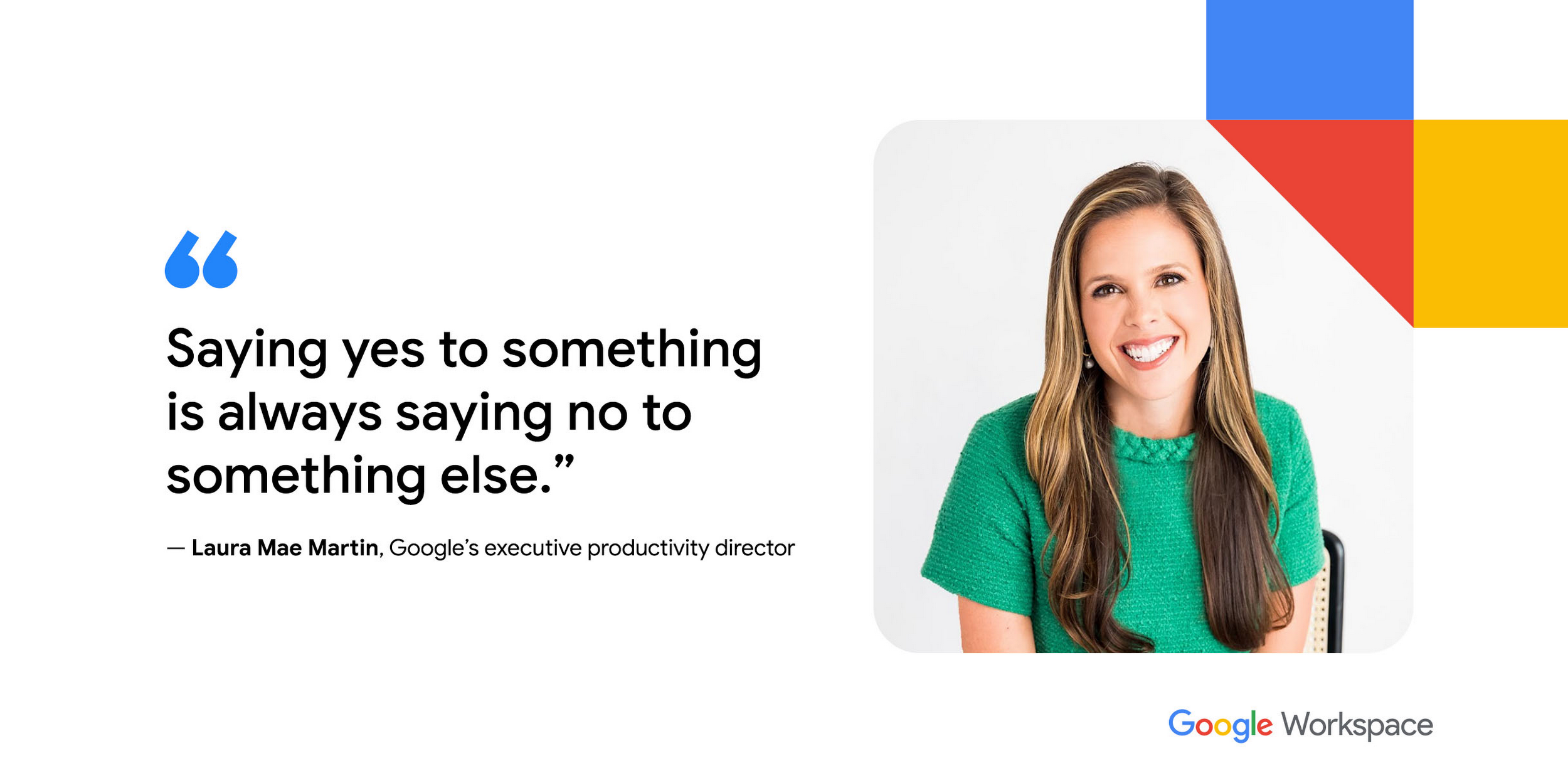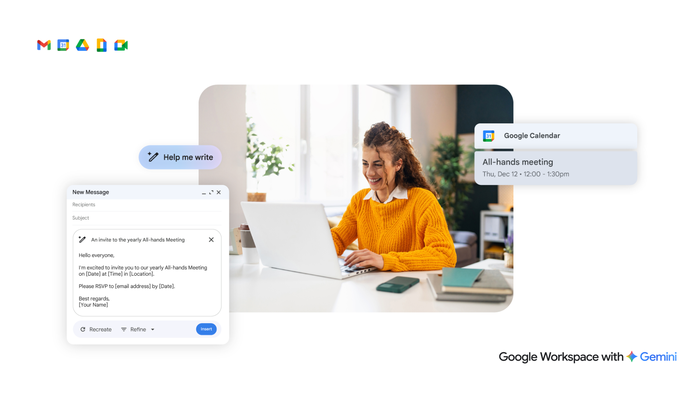Setting priorities and saying no to the rest — with a little help from AI

Laura Mae Martin
Executive Productivity Adviser, Google
Google Workspace Newsletter
Keep up with the evolving future of work and collaboration with insights, trends, and product news.
SIGN UPLaura Mae Martin is the executive productivity advisor at Google. She runs the Productivity@Google program for all employees and hosts a popular YouTube series, “Google Workspace productivity tips.” Her book “Uptime: A Practical Guide to Personal Productivity and Wellbeing” launched on April 2. We asked her how she sets priorities and maximizes her uptime.
Set priorities instead of goals
Whenever I deliver training on productivity, I explain why I prefer to focus on priorities instead of goals. Goals have a tendency to feel abstract and “far off,” while priorities are focused on the present. Priorities are clear and more immediate. Besides, isn’t happiness always the goal? Anything we add to our goals list is something we hope to achieve because we expect to feel happy when it’s completed. Through this lens, we can take the shortcut and just make happiness the ultimate goal. And the way to get to that day-to-day happiness is through setting the right priorities — focusing on the right things, at the right time, in the right way.
Be selective, then commit
I suggest choosing three priorities because that tends to be the best number for our brains to remember. Choosing three reminds us that time is finite, and helps cement the trade-off mindset. Very few of us can focus on 10 large things at any one time. So, thinking about and verbalizing our current “top three priorities” helps us assess new opportunities while also helping anyone we work with know what we’re focused on.
Of course, there will be other smaller priorities that settle in — but I picture it like rocks, pebbles, and sand in a jar. We have to put the large rocks (big priorities) in the jar first, then let the other smaller things fill in space above and around them. Trying to add big rocks to a jar full of sand is pretty much impossible.
When deciding on my priorities, I like to think about Future Me. Imagine it’s six months from now. What is Future Me saying about the things I’ve been focused on? Am I saying, “Wow, I’m really glad I put extra time into that project at work”? Or, “I’m really glad I made room in my work commitments to complete that big move with my family”?
What will you be glad you spent time on? Exploring this can help shape and define your priorities (which I recommend evaluating every three to six months).
Once you have your priorities — shout them from the rooftops! Write them on a post-it note and stick them on your laptop. Tell your teammates and your manager, and make sure everyone is aligned. List them somewhere that’s visible to you and your team every day. Defining priorities helps you focus on them. It’s tempting to accept the invitation to join that new project, but ask yourself if that really helps you focus on these top three things you care about right now.
When “urgent” activities pop up — and they always do — it helps to differentiate urgent from important. “Urgent” (which demands immediate attention and is time sensitive) doesn’t always necessarily mean “important” (aligned to your priorities). To avoid getting sidetracked, ask yourself whether these “urgent” things are truly important — do they align with your priorities or just with somebody else’s?
Say no to everything, except the things you say yes to
Saying no can feel uncomfortable. I am a recovering yes-sayer. It was really hard for me to say no. I wanted to be protective of my time but also maintain social capital and rapport with friends and colleagues. And I learned to walk that very delicate line with the right approach to saying no.
This is why I provide actual sentences in my book Uptime that you can use as part of a thoughtful strategy for saying no. Some examples include “No, but…” and point the requester to another person, resource, or place that can provide the needed help. Some ask for time to think about it before answering, because often three days of thinking it through leads to a different decision than my immediate gut reaction.
A few ways to say no to incoming requests
These ways of saying no make the requester feel supported and respected, while allowing you to protect your time and priorities.
Ask more questions
- “Thanks for thinking of me. Approximately how much time would this take each week? What outcomes are you trying to achieve?”
Say you’ll think about it, or don’t respond right away
- “It was great to hear about your new tool. I’ll get back to you with the level of commitment I can provide, if any, given my current priorities.”
Suggest no, but…
- “Can you send over your questions? Maybe we don’t need a meeting and I can provide answers over email.”
- “I can’t make the meeting, but here are some training modules that I think could help with your goals.”
Offer no, because…
- “I wish I could, but, unfortunately, I’m blocking my calendar for a few things that are coming up this quarter.”
- “I see Amy from my team is already attending this meeting and she has more context on this, so I won’t be attending.”
You can even use these tactics in reverse to get a “yes” when you make a request of someone. Get ahead of someone saying “no” to you by giving the full context and highlighting how your request aligns with something they’re also focused on, describing what success looks like, and providing options on how they can be involved.
Use AI tools to execute on priorities
Having priorities and sticking to them makes it easier to be productive. Doing less helps us do more, better. We get happiness knowing that we’ve decided what we wanted to focus on (set an intention), we’ve made the time to do it (by saying no to other things in our schedule), and then we’ve done it well.
New tools can help with these efforts, but it’s important to understand how they can help. It’s worth investing some time to learn more about AI tools like Gemini for Google Workspace — and how they can help create the space to focus on the things that matter most. For example, Gemini can help you draft an email to say no the right way, or it can take notes for you in a meeting so you can focus fully on the conversation. Or if your priority is planning a huge event this month, Gemini can help you research venues, plan the schedule, create the invites, and keep all of the data organized. The ways to use AI are endless, but the goal is to lean on AI so that you can spend more time focused on your priorities. And that is the definition of productivity — or, what I call, finding your “Uptime.”



